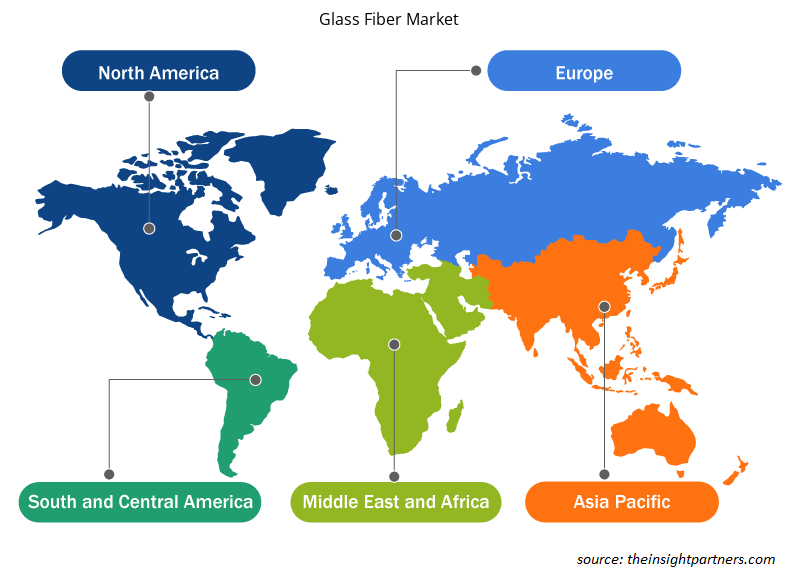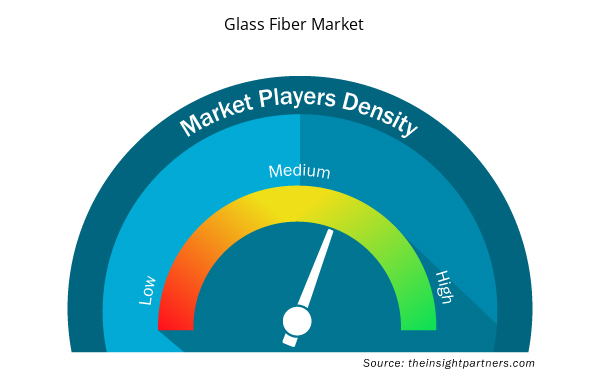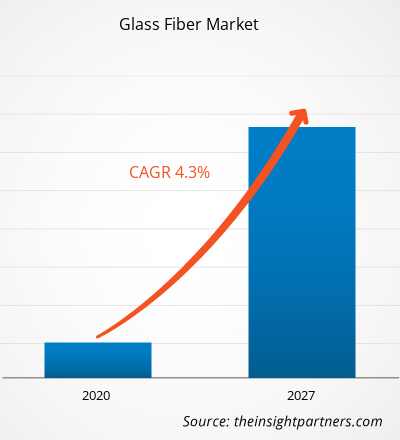ガラス繊維市場は2019年に141億9,355万米ドルと評価され、2020年から2027年にかけて4.3%のCAGRで成長し、2027年には198億3,762万米ドルに達すると予測されています。
ガラス繊維は、糸にまとめられ、織物に織り込まれた極細のガラス繊維からなる材料です。シリカ (SiO2)、石灰石、ソーダ灰を 3 段階の炉で混合して溶かし、溶融ガラスを炉底のブッシングから押し出し、フィラメントを水で冷却して作られます。ガラス繊維は、耐腐食性に優れ、剛性と強度が高く、引張強度が高く、耐熱性と耐久性に優れています。これらの繊維は、自動車、建設、海洋、風力エネルギー、航空宇宙および防衛などの最終用途産業で使用されています。ただし、生産プロセスの課題、新しいテクノロジーのコスト集約型の性質、ガラス繊維の利益率が低いことが、市場の成長を制限しています。
2019年、アジア太平洋地域は世界のガラス繊維市場で最大のシェアを占めました。今後数年間、アジア太平洋地域はガラス繊維の最速成長市場になると予想されています。輸送、建設、電気・電子、航空宇宙、その他の産業の成長に伴い、この地域のガラス繊維の需要は大幅に増加しています。建設業界はガラス繊維の主な消費者の1つです。インドや中国などの新興市場での急速なインフラ開発は、高度なガラス繊維の需要を促進しています。たとえば、インド政府は住宅や輸送インフラの改善に多大な努力を払ってきました。インド産業貿易促進局(DPIIT)によると、2000年4月から2020年9月までの建設開発部門とインフラ活動への外国直接投資(FDI)は、それぞれ257億8,000万米ドルと172億2,000万米ドルに達しました。インフラ開発への継続的な投資は、ガラス繊維の消費を大幅に押し上げるでしょう。さらに、ガラス繊維は海洋、航空エネルギー、消費財産業でも使用されており、これらの産業も政府からの多額の投資を受けており、この地域のガラス繊維市場の成長を支えています。
COVID-19は2019年12月に武漢(中国)で最初に発生し、それ以来世界中に急速に広がっています。2021年3月現在、確認された症例数と報告された死亡者数で最も影響を受けている国には、米国、インド、ブラジル、ロシア、フランス、英国、トルコ、イタリア、スペインなどがあります。COVID-19のパンデミックは、ロックダウン、渡航禁止、事業停止により、さまざまな国の経済や産業に影響を及ぼしています。これに加えて、ヨーロッパ、アジア、北米の国々が課した世界的な渡航禁止は、ビジネスコラボレーションやパートナーシップの機会に影響を与えています。これらすべての要因が化学および材料業界に悪影響を及ぼし、ガラス繊維市場の成長を抑制する要因となることが予想されます。
要件に合わせてレポートをカスタマイズする
このレポートの一部、国レベルの分析、Excelデータパックなど、あらゆるレポートを無料でカスタマイズできます。また、スタートアップや大学向けのお得なオファーや割引もご利用いただけます。
- このレポートの主要な市場動向を入手してください。この無料サンプルには、市場動向から見積もりや予測に至るまでのデータ分析が含まれます。
市場分析
建設業界におけるガラス繊維の需要増加
ガラス繊維は、建設分野で断熱材、表面コーティング、被覆材、屋根材の原料として使用されています。安価で、剛性、柔軟性、透明性、耐薬品性、不活性などの機械的特性は、ポリマーや炭素繊維などの他の繊維とほぼ同等です。ガラス繊維は、壁、暖炉の周囲、基礎、被覆材、洗面台、コンクリート製カウンタートップの建設に使用されるガラス繊維強化コンクリートに使用されています。主に、建物の外装壁パネルや建築用プレキャストコンクリートとして使用されています。ガラス繊維は、高い引張強度を提供し、コンクリートを柔軟でひび割れに強いものにする主要なキャリアとして機能します。耐アルカリ性ガラス繊維 (ARGF) は、建設資材に広く使用されています。ARGF は、コンクリートの引張強度、曲げ靭性、破壊係数、耐摩耗性を大幅に向上させます。このようなコンクリートはひび割れ防止に使用されるため、建設分野で幅広く使用されています。
世界の建設業界の急速な発展により、ガラス繊維の需要が増加すると予想されています。米国などの先進国での住宅の新築がガラス繊維の需要を支えています。たとえば、米国国勢調査局によると、2020年3月の米国での建築許可を受けた住宅の総数は、前年比1,353,000戸で、2019年3月比5%増でした。これとは別に、中国やインドなどの新興市場の力強い経済成長により、堅調なインフラ整備が進んでいます。これらの国では、新築ビルの建設、既存構造物の保守・修理、改造、改修、プレカットの現場での組み立て、仮設ビルの建設、エレベーターやエスカレーターなどの特殊な建築設備の設置が増加しています。これらすべての要因により、建設業界ではガラス繊維の安定した需要が生まれると予想されます。
繊維タイプの洞察
繊維の種類に基づいて、世界のガラス繊維市場は、E / ECRガラス繊維、Sガラス繊維、Cガラス繊維、その他に分類されます。 E / ECRガラス繊維セグメントは、2019年に最高の市場シェアでガラス繊維市場をリードしました。 Eガラスは電子ガラスであり、高強度、優れた絶縁性、耐水性、耐腐食性などの特性を備えた主要なタイプのガラス繊維の1つです。 Eガラス繊維は、コストが手頃で弾性率が低く、他のガラス繊維よりも早く開発されたため、すべての繊維強化材と繊維強化複合材の中で最も広く使用されています。 一方、ECRガラスはEガラスに似ていますが、フッ素とホウ素が含まれていません。 ECRガラス繊維は環境に優しく、耐酸性、耐水性、耐熱性、耐アルカリ性に優れています。 さらに、ECRガラス繊維は誘電強度が優れ、電気漏れが少なく、表面抵抗が大きいです。 ECR ガラス繊維は、2005 年 1 月から ASTM-D578-1999 規格に基づいて製造されており、透明 FRP (繊維強化プラスチック) パネル用途を除くすべての電子ガラス用途に適しています。自動車、電子機器、電子器具における E/ECR ガラス繊維の広範な使用は、予測期間中にセグメントの成長を促進すると予想されます。
製品タイプの洞察
製品タイプに基づいて、世界のガラス繊維市場は、シングルエンドロービング、マルチエンドロービング、織りロービング、その他に分類されます。その他セグメントは、2019年に世界のガラス繊維市場をリードしました。その他セグメントには、ファブリック、CSM、CFM、DUCS、CS、OptiSprayロービング、Cem-FILロービング、ダイレクトロービングなどが含まれます。OptiSprayロービングは、時間と樹脂を節約しながら製品のパフォーマンスを向上させたい製造業者にとって魅力的なソリューションです。Cem-FILロービングは、同時スプレー法によるガラス繊維強化コンクリート複合材の製造に使用するために製造された、耐アルカリ性のガラス繊維組み立てロービングです。Cem-FILロービングは、耐アルカリ性ガラス、良好な巻き戻し、容易なチョッピング、高い分割効率などの利点があり、複雑なプロファイルや優れた機械的性能での使用に最適です。 Owens Corning などのメーカーは、OptiSpray F Roving、Cem-FILRoving 5325、Cem-FILRoving 62.4、Cem-FIL Roving 62/70 を提供しています。Saint-Gobain Vetrotex は、E-Glass 製のスプライスフリーのシングルエンドロービングで、複数の繊維技術に適した Direct Roving を提供しています。
アプリケーションインサイト
用途に基づいて、世界のガラス繊維市場は、海洋、輸送、航空宇宙、建設、電気および電子、消費財、その他に分類されます。
2019年、輸送部門が世界のガラス繊維市場をリードしました。ガラス繊維は、ルーフパネル、ドア、窓、冷却ベンチレーター、荷物入れ、座席、ヘッドレストの背面パネルなど、輸送業界で使用されています。ガラス繊維は強度と重量の比率が高く、自動車の製造に不可欠な要素です。これらの要因により、予測期間中に輸送業界のガラス繊維市場の成長が促進されると予想されます。
製造プロセスの洞察
製造プロセスに基づいて、世界のガラス繊維市場は、ハンドレイアップ、スプレーアップ、プリプレグレイアップ、射出成形、圧縮成形、樹脂注入、その他に分類されます。その他セグメントは、2019年に世界のガラス繊維市場をリードしました。その他セグメントには、プルトルージョン、遠心鋳造、ハイブリッド射出成形/熱成形などが含まれます。プルトルージョンは、低コストでシンプルな連続プロセスであり、ガラス繊維とポリエステル樹脂で数十年にわたって使用されてきました。それでも、最近では、このプロセスは高度な複合材料アプリケーションにも応用されています。プルトルージョンでは、通常、後処理を必要としない滑らかな完成部品が生成されます。遠心鋳造法では、エポキシ樹脂またはビニルエステル樹脂を150Gの遠心回転金型に注入し、金型の内面に巻き付けられた織物に浸透させます。
グラスファイバー市場で活動している主要な市場プレーヤーとしては、ジョンズ・マンビル、ジュシ株式会社、重慶ポリコンプ・インターナショナル社(CPIC)、ゴア・グラスファイバー社、日本電気硝子株式会社、サンゴバン・ベトロテックス、四川微博新材料集団株式会社、泰山グラスファイバー社、台湾玻璃集団、オーウェンス・コーニングなどが挙げられます。これらの企業は世界中に製品を提供しており、より幅広い顧客層に対応するのに役立っています。市場の主要プレーヤーは、顧客の要件を満たす高品質で革新的な製品の開発に重点を置いています。過去数年間、市場で活動している企業は、グラスファイバー市場に関連する計り知れない可能性を認識し、合併や買収、製品の発売などの戦略に深く関わってきました。たとえば、2020年にジュシは軽量風力タービンブレードの開発を促進するためにE9超高弾性ガラス繊維を発売しました。
ガラス繊維市場の地域別分析
予測期間を通じてガラス繊維市場に影響を与える地域的な傾向と要因は、Insight Partners のアナリストによって徹底的に説明されています。このセクションでは、北米、ヨーロッパ、アジア太平洋、中東、アフリカ、南米、中米にわたるガラス繊維市場のセグメントと地理についても説明します。

- ガラス繊維市場の地域別データを入手
ガラス繊維市場レポートの範囲
| レポート属性 | 詳細 |
|---|---|
| 2019年の市場規模 | 141億9千万米ドル |
| 2027年までの市場規模 | 198.4億米ドル |
| 世界のCAGR(2019年 - 2027年) | 4.3% |
| 履歴データ | 2017-2018 |
| 予測期間 | 2020-2027 |
| 対象セグメント | 繊維の種類別
|
| 対象地域と国 | 北米
|
| 市場リーダーと主要企業プロフィール |
|
ガラス繊維市場のプレーヤー密度:ビジネスダイナミクスへの影響を理解する
グラスファイバー市場は、消費者の嗜好の変化、技術の進歩、製品の利点に対する認識の高まりなどの要因により、エンドユーザーの需要が高まり、急速に成長しています。需要が高まるにつれて、企業は提供を拡大し、消費者のニーズを満たすために革新し、新たなトレンドを活用し、市場の成長をさらに促進しています。
市場プレーヤー密度とは、特定の市場または業界内で活動している企業または会社の分布を指します。これは、特定の市場スペースに、その市場規模または総市場価値に対してどれだけの競合相手 (市場プレーヤー) が存在するかを示します。
ガラス繊維市場で事業を展開している主要企業は次のとおりです。
- ジョンズ・マンヴィル
- ジューシ株式会社
- 重慶ポリコンプインターナショナルコーポレーション(CPIC)
- ゴアグラスファイバー株式会社
- 日本電気硝子株式会社
免責事項:上記の企業は、特定の順序でランク付けされていません。

- ガラス繊維市場のトップキープレーヤーの概要を入手
レポートの注目点
- 世界のガラス繊維市場における進歩的な業界動向は、プレーヤーが効果的な長期戦略を策定するのに役立ちます。
- 先進国市場と発展途上国市場で採用されているビジネス成長戦略
- 2017年から2027年までの世界のガラス繊維市場の定量分析
- さまざまな業界におけるガラス繊維の需要の推定
- 市場の成長を予測するために業界で活動するバイヤーとサプライヤーの有効性を示すPEST分析
- 競争市場シナリオとガラス繊維の需要を理解するための最近の動向
- ガラス繊維市場の成長を牽引・抑制する要因と相まって、市場動向と見通し
- 世界のガラス繊維市場の成長に関する商業的利益を支える戦略を理解することによる意思決定プロセス
- 市場のさまざまなノードにおけるガラス繊維市場規模
- 世界のガラス繊維市場の詳細な概要とセグメンテーション、および業界におけるその動向
- 有望な成長機会があるさまざまな地域のガラス繊維市場規模
世界のガラス繊維市場(繊維タイプ別)
- E/ECR-ガラス繊維
- S-グラスファイバー
- C-ガラス繊維
- その他
世界のガラス繊維市場、製品タイプ別
- シングルエンドロービング
- マルチエンドロービング
- 織りロービング
- その他
世界のガラス繊維市場、用途別
- 海洋
- 交通機関
- 航空宇宙
- 工事
- 電気・電子
- 消費財
- その他
世界のガラス繊維市場、製造プロセス別
- ハンドレイアップ
- スプレーアップ
- プリプレグレイアップ
- 射出成形
- 圧縮成形
- 樹脂注入
- その他
企業プロフィール
- 重慶ポリコンプインターナショナルコーポレーション(CPIC)
- ジョンズ・マンヴィル
- 中国樹脂株式会社
- 日本電気硝子株式会社
- オーウェンス・コーニング
- サンゴバンSA
- 四川微博新材料グループ株式会社
- タイシャンファイバーグラス株式会社(CTG)
- 台湾ガラスグループ
- ゴア・グラスファイバー・リミテッド
- 過去2年間の分析、基準年、CAGRによる予測(7年間)
- PEST分析とSWOT分析
- 市場規模価値/数量 - 世界、地域、国
- 業界と競争環境
- Excel データセット


- Hydrogen Storage Alloys Market
- Retinal Imaging Devices Market
- Explosion-Proof Equipment Market
- Enzymatic DNA Synthesis Market
- Occupational Health Market
- Environmental Consulting Service Market
- Greens Powder Market
- Dry Eye Products Market
- Authentication and Brand Protection Market
- Collagen Peptides Market

Report Coverage
Revenue forecast, Company Analysis, Industry landscape, Growth factors, and Trends

Segment Covered
This text is related
to segments covered.

Regional Scope
North America, Europe, Asia Pacific, Middle East & Africa, South & Central America

Country Scope
This text is related
to country scope.
よくある質問
In 2019, The E/ECR-glass fiber segment accounted for a larger share of the global glass fiber market. E-glass is among the leading types of glass fibers with properties such as high-strength, good insulation, water-resistance, and corrosion resistance. It is extensively used in aerospace, marine, and industrial applications. Apart from this, E-glass finds vast applications in automotive & transport, construction, wind energy and pipes & tanks due to its beneficial characteristics and low-cost. ECR-glass fiber also called electronic glass fiber has a high mechanical strength, good waterproofing ratio and electrical acidic and alkali corrosion resistance as compared to E-glass fiber. It is used in transparent GRP panel applications. Growing demand from various end-use industries has spurred the growth of this segment during the forecast period.
The key players providing glass fibers are Johns Manville; Jushi Co., Ltd.; Chongqing Polycomp International Corp. (CPIC); Goa Glass Fiber Ltd; Nippon Electric Glass Co. Ltd; Saint-Gobain Vetrotex; Sichuan Weibo New Material Group Co., Ltd.; Taishan Fiberglass Inc; Taiwan Glass Group; and Owens Corning among others
In 2019 , the pressure vessel composite materials market was dominated by Asia Pacific. With the growth of transportation, construction, electrical & electronics, aerospace, and other industries, the demand for glass fiber has substantially gone up in the region. Construction industry is among the major consumers of glass fibers. Rapid infrastructural development in emerging markets such as India and China is driving the demand for advanced glass fibers. In addition, Glass fibers are also used in marine, wing energy and consumer goods industry, these industries are also experiencing high investment from government and thus supporting the growth of glass fibers market in region.
Trends and growth analysis reports related to Chemicals and Materials : READ MORE..
The List of Companies - Global Glass Fibers Market
- Johns Manville
- Jushi Co., Ltd.
- Chongqing Polycomp International Corp. (CPIC)
- Goa Glass Fiber Ltd
- Nippon Electric Glass Co. Ltd
- Saint-Gobain Vetrotex
- Sichuan Weibo New Material Group Co., Ltd.
- Taishan Fiberglass Inc
- Taiwan Glass Group
- Owens Corning
The Insight Partners performs research in 4 major stages: Data Collection & Secondary Research, Primary Research, Data Analysis and Data Triangulation & Final Review.
- Data Collection and Secondary Research:
As a market research and consulting firm operating from a decade, we have published and advised several client across the globe. First step for any study will start with an assessment of currently available data and insights from existing reports. Further, historical and current market information is collected from Investor Presentations, Annual Reports, SEC Filings, etc., and other information related to company’s performance and market positioning are gathered from Paid Databases (Factiva, Hoovers, and Reuters) and various other publications available in public domain.
Several associations trade associates, technical forums, institutes, societies and organization are accessed to gain technical as well as market related insights through their publications such as research papers, blogs and press releases related to the studies are referred to get cues about the market. Further, white papers, journals, magazines, and other news articles published in last 3 years are scrutinized and analyzed to understand the current market trends.
- Primary Research:
The primarily interview analysis comprise of data obtained from industry participants interview and answers to survey questions gathered by in-house primary team.
For primary research, interviews are conducted with industry experts/CEOs/Marketing Managers/VPs/Subject Matter Experts from both demand and supply side to get a 360-degree view of the market. The primary team conducts several interviews based on the complexity of the markets to understand the various market trends and dynamics which makes research more credible and precise.
A typical research interview fulfils the following functions:
- Provides first-hand information on the market size, market trends, growth trends, competitive landscape, and outlook
- Validates and strengthens in-house secondary research findings
- Develops the analysis team’s expertise and market understanding
Primary research involves email interactions and telephone interviews for each market, category, segment, and sub-segment across geographies. The participants who typically take part in such a process include, but are not limited to:
- Industry participants: VPs, business development managers, market intelligence managers and national sales managers
- Outside experts: Valuation experts, research analysts and key opinion leaders specializing in the electronics and semiconductor industry.
Below is the breakup of our primary respondents by company, designation, and region:

Once we receive the confirmation from primary research sources or primary respondents, we finalize the base year market estimation and forecast the data as per the macroeconomic and microeconomic factors assessed during data collection.
- Data Analysis:
Once data is validated through both secondary as well as primary respondents, we finalize the market estimations by hypothesis formulation and factor analysis at regional and country level.
- Macro-Economic Factor Analysis:
We analyse macroeconomic indicators such the gross domestic product (GDP), increase in the demand for goods and services across industries, technological advancement, regional economic growth, governmental policies, the influence of COVID-19, PEST analysis, and other aspects. This analysis aids in setting benchmarks for various nations/regions and approximating market splits. Additionally, the general trend of the aforementioned components aid in determining the market's development possibilities.
- Country Level Data:
Various factors that are especially aligned to the country are taken into account to determine the market size for a certain area and country, including the presence of vendors, such as headquarters and offices, the country's GDP, demand patterns, and industry growth. To comprehend the market dynamics for the nation, a number of growth variables, inhibitors, application areas, and current market trends are researched. The aforementioned elements aid in determining the country's overall market's growth potential.
- Company Profile:
The “Table of Contents” is formulated by listing and analyzing more than 25 - 30 companies operating in the market ecosystem across geographies. However, we profile only 10 companies as a standard practice in our syndicate reports. These 10 companies comprise leading, emerging, and regional players. Nonetheless, our analysis is not restricted to the 10 listed companies, we also analyze other companies present in the market to develop a holistic view and understand the prevailing trends. The “Company Profiles” section in the report covers key facts, business description, products & services, financial information, SWOT analysis, and key developments. The financial information presented is extracted from the annual reports and official documents of the publicly listed companies. Upon collecting the information for the sections of respective companies, we verify them via various primary sources and then compile the data in respective company profiles. The company level information helps us in deriving the base number as well as in forecasting the market size.
- Developing Base Number:
Aggregation of sales statistics (2020-2022) and macro-economic factor, and other secondary and primary research insights are utilized to arrive at base number and related market shares for 2022. The data gaps are identified in this step and relevant market data is analyzed, collected from paid primary interviews or databases. On finalizing the base year market size, forecasts are developed on the basis of macro-economic, industry and market growth factors and company level analysis.
- Data Triangulation and Final Review:
The market findings and base year market size calculations are validated from supply as well as demand side. Demand side validations are based on macro-economic factor analysis and benchmarks for respective regions and countries. In case of supply side validations, revenues of major companies are estimated (in case not available) based on industry benchmark, approximate number of employees, product portfolio, and primary interviews revenues are gathered. Further revenue from target product/service segment is assessed to avoid overshooting of market statistics. In case of heavy deviations between supply and demand side values, all thes steps are repeated to achieve synchronization.
We follow an iterative model, wherein we share our research findings with Subject Matter Experts (SME’s) and Key Opinion Leaders (KOLs) until consensus view of the market is not formulated – this model negates any drastic deviation in the opinions of experts. Only validated and universally acceptable research findings are quoted in our reports.
We have important check points that we use to validate our research findings – which we call – data triangulation, where we validate the information, we generate from secondary sources with primary interviews and then we re-validate with our internal data bases and Subject matter experts. This comprehensive model enables us to deliver high quality, reliable data in shortest possible time.


 このレポートの無料サンプルを入手する
このレポートの無料サンプルを入手する